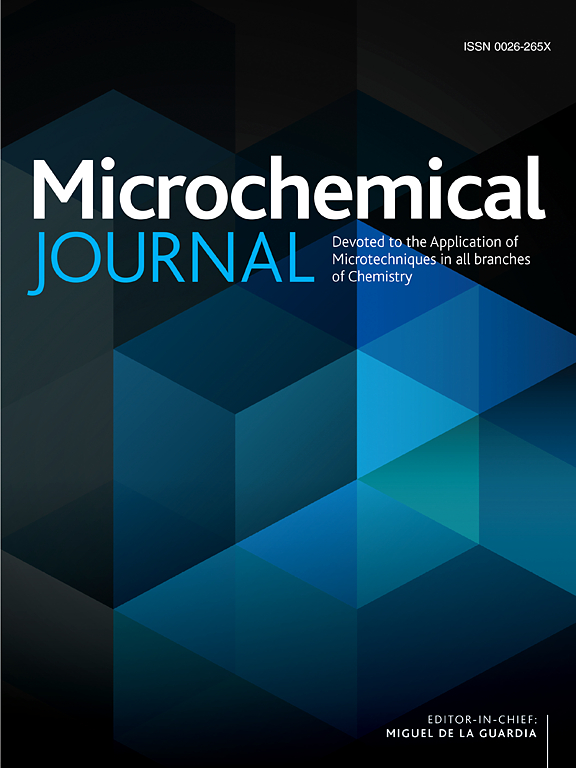An eco-friendly approach developed for the microextraction of N-nitrosamines in water and beverage samples with deep eutectic solvent and multivariate optimization
IF 4.9
2区 化学
Q1 CHEMISTRY, ANALYTICAL
引用次数: 0
Abstract
N-nitrosamines are a class of environmental and beverage contaminants known for their carcinogenic potential in humans. In this study, a deep eutectic solvent was employed in hollow fiber microporous membrane liquid-liquid extraction for the determination and quantification of six nitrosamines (N-nitrosopyrrolidine, N-nitrosomethylethylamine, N-nitrosopiperidine, N-nitrosodiethylamine, N-nitrosodi-n-propylamine, and N-nitrosodi-n-butylamine) in water and beverages by high-performance liquid chromatography and diode array detection. The deep eutectic solvent was selected using a univariate strategy, while the subsequent steps were optimized through multivariate approaches. A simplex-centroid design with a process variable was employed to optimize the solvent mixture and desorption time, whereas a Box-Behnken design was used to optimize pH, NaCl concentration, and extraction time. The optimized conditions were comprised of levulinic acid: thymol (1:1) as extractor solvent; a mixture of 45 μL of methanol, 111 μL of ultrapure water, and 144 μL of ethanol was used as desorption solvent, and the desorption time was fixed at 20.4 min; and extraction time last 31.5 min, at pH 3.9 and 8.5 % (w/v) of NaCl. For all curves in ultrapure water, ANOVA values were statistically validated. LODs and LOQs were 3.3 and 10 μg L−1 for all analytes. Intraday and interday precision ranged from 2.3 % to 18.3 % and 5.2 % to 19.7 %, respectively. The relative recoveries were obtained in vinegar samples, and the range was 74.2 % to 119.2 %. Five samples, collected from a river, a lagoon, and three beverages, were analyzed using the proposed methodology. The analyte concentrations were not detected in these samples or were lower than the LOQ.

建立了水和饮料样品中n -亚硝胺的深共晶溶剂微萃取和多元优化方法
n -亚硝胺是一类环境和饮料污染物,因其对人类的致癌潜力而闻名。本研究采用中空纤维微孔膜液-液萃取法,采用高效液相色谱和二极管阵列检测,对水和饮料中的6种亚硝胺(n-亚硝基soprolidine、n-亚硝基somethy乙胺、n-亚硝基sopiperidine、n-亚硝基二乙胺、n-亚硝基-正丙胺和n-亚硝基-正丁胺)进行了定量测定。采用单变量策略选择深共晶溶剂,并通过多变量方法对后续步骤进行优化。采用带工艺变量的简单质心设计优化溶剂配比和脱附时间,采用Box-Behnken设计优化pH、NaCl浓度和提取时间。优化条件为:乙酰丙酸:百里香酚(1:1)为提取溶剂;以45 μL甲醇、111 μL超纯水和144 μL乙醇为解吸溶剂,固定解吸时间为20.4 min;在pH为3.9、NaCl浓度为8.5% (w/v)的条件下,提取时间为31.5 min。对于超纯水中的所有曲线,方差分析值进行统计验证。所有分析物的lod和loq分别为3.3和10 μ L−1。日内和日间精度分别为2.3% ~ 18.3%和5.2% ~ 19.7%。对食醋样品的相对加样回收率为74.2% ~ 119.2%。从一条河流、一个泻湖和三种饮料中收集的五个样本使用所提出的方法进行了分析。在这些样品中未检测到分析物浓度或低于定量限。
本文章由计算机程序翻译,如有差异,请以英文原文为准。
求助全文
约1分钟内获得全文
求助全文
来源期刊

Microchemical Journal
化学-分析化学
CiteScore
8.70
自引率
8.30%
发文量
1131
审稿时长
1.9 months
期刊介绍:
The Microchemical Journal is a peer reviewed journal devoted to all aspects and phases of analytical chemistry and chemical analysis. The Microchemical Journal publishes articles which are at the forefront of modern analytical chemistry and cover innovations in the techniques to the finest possible limits. This includes fundamental aspects, instrumentation, new developments, innovative and novel methods and applications including environmental and clinical field.
Traditional classical analytical methods such as spectrophotometry and titrimetry as well as established instrumentation methods such as flame and graphite furnace atomic absorption spectrometry, gas chromatography, and modified glassy or carbon electrode electrochemical methods will be considered, provided they show significant improvements and novelty compared to the established methods.
 求助内容:
求助内容: 应助结果提醒方式:
应助结果提醒方式:


